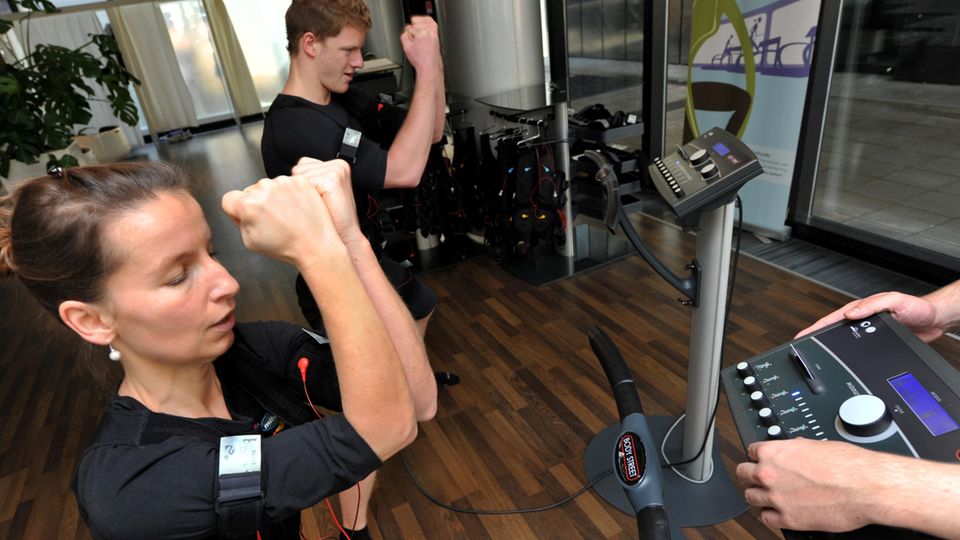Fitness trend
EMS training-how it works and who really brings something
Ems actually sounds too good to be true. Only 20 minutes of electrical myo stimulation per week-then it also works with the washboard belly. Is that true?
They have been sprouting out like mushrooms in large cities for years. Well -trained athletes adorn their shop windows – cheeky claims and screens with videos are supposed to lure customers in. EMS studios. Many don’t even know what Ems stands for. You can’t do anything with EMS training.
What does the abbreviation EMS actually stand for?
EMS is the abbreviation for electrical myo stimulation, whereby “Myo”-derived from ancient Greek “Mys”-means nothing more than muscle. And the name suggests that the EMS is about controlling and stimulating the muscles or individual muscle fibers in a targeted manner from the outside using electrical impulses. The goal: to achieve more intensive muscle tension than is possible through willing control. A basically simple and recognized principle that physiotherapists have been used in rehabilitation since the 1970s. For example, to treat muscular injuries such as strains or a fiber tear, to rebuild the weakened muscles after operations or to improve their control and, in the best case, to shorten the healing process. A few years ago, the somewhat more cumbersome and dusty term stimulus flow therapy became the much more gripper abbreviation EMS. And this developed the EMS training.
EMS is no longer used alone for therapeutic purposes: In the meantime, EMS training successfully mixes in the hard-fought fitness market. In 2018 there are said to have already been around 2500 so-called micro studios in Germany alone, in which EMS training was offered. In addition to leisure and popular sports, EMS is also increasingly finding supporters in performance and high-performance sports. For example, it is a recognized training method in triathlon, but also in badminton, cycling and swimming.
How does EMS training work?
The following scenario: You are in the gym and want to train your biceps. In the hand a dumbbell, keep your arm stretched out and relaxed next to your body. The plan: You want to turn the elbow to get the barbell up and tense the upper arm muscle. Before this movement takes place, the synapses at the ends of the nerve cells in the brain send electrochemical signals through the body to the individual muscle cells. The arm is bent, the biceps tighten. During EMS training, small electrodes now take over or support the work of the synapses. This is possible because the muscle fibers don’t care whether the commands to be carried out come from the brain or a machine. As a rule, these are incorporated into special vests or integrated into pods that are glued to the athletes’ skin before the training session. The electrodes now also send electrical impulses – low -frequency current blows with a voltage of about nine volts and between 50 and 90 milliams – strongly to the muscles below, which contracts accordingly. Depending on the practice and setting of the device, an impulse during EMS training takes between one and five seconds. Ultimately, he strengthens what else you sweat on the dumbbell bench or on the leg press – muscle building.
EMS training = six-pack from the socket?
Is it enough to stand in an EMS studio once or twice a week with a damp electron vest? As a rule, this is usually not as comfortable and stress-free as it sounds at first. Because mere stimulating the muscles using electricity pulses, the so-called isometric or static EMS training, activates the muscles, but according to experts, they only grow to a limited extent. Noticeably more-and this proves numerous studies (among other things by scientists from the German Sport University Cologne and the University of Erlangen)-brings EMS training if the muscle fibers are also controlled arbitrarily. This means that the athlete tenses the muscle group to be trained on his own will – in parallel, the stream pulse comes from the machine and intensifies the exercise. The combination of the two components is also called dynamic EMS training.
Important: All variants of the EMS training should be carried out urgently under supervision and with the guidance of a qualified and well-trained trainer.
How effective or efficient is EMS training?
For many years, a confusing message from the German Sport University Cologne was circulated in which it was claimed that EMS training was 18 times more efficient than conventional fitness training. A number that quickly became independent. The data was based on an investigation by the Cologne scientist Dr. Heinz Kleinöder at the concentration of Creatin-Kinase (CK). CK is an enzyme that is released in intensive strength and muscle training and used by sports scientists as an indicator of training control. This value expressly does not serve as an indication of greater efficiency. Because an excessive CK value harbors health risks, especially with little and completely untrained people. But more about that later.
Professor Dr. Wolfgang Kemmler (Friedrich Alexander University Erlangen-Nuremberg) has made the parameters of muscle mass, muscle strength and body fat to check EMS training for its efficiency over conventional strength training. Compared to the so-called high intensity training (HIT), a progressive and also less time-consuming strength training, his team could not find any significant differences. Because the most important parameters, including the blood and belly fat values, developed significantly positively, the sports doctor came to the conclusion that both HIT and EMS training are not only time-saving, but also suitable for increasing the performance of untrained men in medium age.
Positive effects through EMS training
The already mentioned Dr. Kleinöder has dealt with the physiological effects in various research projects that cause full-body EMS training. Among other things, the sports scientist found that EMS training in people with chronic heart weakness strengthens the muscles controlled by electricity pulse, improves oxygen absorption and has a positive effect on diastolic blood pressure, the lower blood pressure value. Significant climbs of the power values recorded Dr. Kleinöder also with active athletes from various sports. In this group, the isometric maximum force in this group improved by almost 33 percent on average. In the case of untrained, it was still 23.5 percent.
How many calories do you burn during EMS training?
There are also studies on this. Accordingly, 19 young men burned a little more than 400 kcal on average in a 16-minute EMS training. Projected on a 20-minute dynamic EMS training, so 515 kcal would come together. For comparison: During a 20-minute running unit at medium speed, the body burns around 200 kcal.
For whom EMS training is suitable-and for whom not?
Used consciously and correctly, EMS training offers the chance to improve muscle strength both a little and untrained as well as leisure and ambitious popular athletes as well as top athletes to improve muscle strength in a short time. Even seniors can benefit. Because EMS training can-provided that dose is used-slow down the muscle loss on old age. However, the stimulation current training is not an option for patients with chronic heart failure or epilepsy. Caution and support from a physiotherapist or trainer are advisable for infections and implants.
What does high-quality EMS training cost?
Compared to membership in conventional gyms, you have to dig deeper into your pocket for the EMS training in a studio of the great EMS providers. The fitness chains for your EMS training call between 20 and 30 euros per week. With long -term contracts, it usually gets a little cheaper. As a rule, one to two EMS training days per week are agreed. The article usually includes one -time trial training (sometimes also a probe month), an entrance discussion as well as personal support and instructions by a trainer. If you book EMS training in a physiotherapeutic practice or with a personal trainer, it can become a little more expensive.
*This article contains so-called affiliate links to products in online shops. If a user clicks on it and buys something, the publisher receives a commission from the dealer, not from the manufacturer. Of course, where and when you buy a product is up to you.
Source: Stern
I am Pierce Boyd, a driven and ambitious professional working in the news industry. I have been writing for 24 Hours Worlds for over five years, specializing in sports section coverage. During my tenure at the publication, I have built an impressive portfolio of articles that has earned me a reputation as an experienced journalist and content creator.




